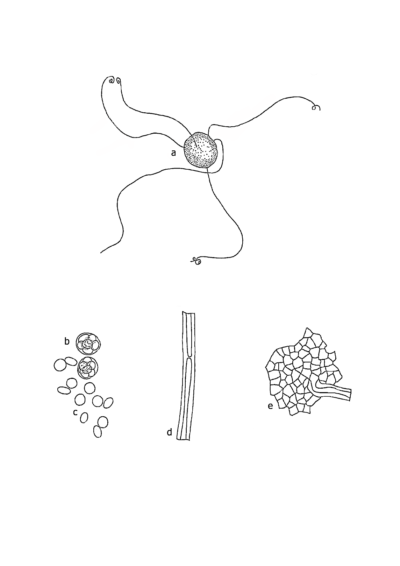Fungalpedia – Note 219, Arachnomyces
Arachnomyces Mass. & Salm.
Citation when using this entry: Weerasinghe et al. 2024 (in prep) – Fungalpedia, genera described in selected orders.
Index Fungorum, Facesoffungi, MycoBank, GenBank, Fig. 1
Classification: Arachnomycetaceae, Arachnomycetales, Eurotiomycetidae, Eurotiomycetes, Pezizomycotina, Ascomycota, Fungi
Arachnomyces was introduced by Massee & Salmon (1902) to accommodate Arachnomyces nitidus as the type species, which was isolated from Plantis putridis in Yorkshire, Northern England. Arachnomyces are commonly found in fragments of rotting plants and rat feces (Massee & Salmon 1902). Additionally, it was found on dung compost and dead grass in Canada (Malloch & Cain 1970). Arachnomyces is morphologically characterized by hyaline mycelia with numerous ampulliform swellings. Perithecia are globose, shining, brittle, non-ostiolate, and produce several long, hair-like appendages. The appendages are septate, flexible, thick-walled, and even in diameter, except for the swollen base. Perithecia are usually found in groups of five or six through their interlaced appendages. Asci are sub-globose to globose, 8-spored, and evanescent. Ascospores are smooth, oblate, and reddish brown (Massee & Salmon 1902). The asexual morph has not been previously reported (Malloch & Cain 1970). Arachnomyces was included within Onygenaceae because the lack of a stipe on the ascocarps was not considered significant enough to justify the exclusion of Arachnomyces from Onygenaceae (Malloch & Cain 1970). Currently, this genus is classified under the Arachnomycetaceae (Wijayawardene et al. 2022). Nuclear SSU rDNA gene sequences have been used to study the phylogeny of the genus (Gibas et al. 2002). There are 15 epithets listed under this genus in the Species Fungorum (2024).
Type species: Arachnomyces nitidus Massee & E.S. Salmon
Other accepted species: (Species Fungorum – search Arachnomyces)
Figure 1 – Arachnomyces nitidus (TRTC 45366, type). a Ascocarp (×57); b Asci(×1500); c Ascospores (×1500); d Detail of ascocarp appendage (×1500); e Surface view of peridium (×650). Redrawn from Malloch & Cain (1970).
References
Malloch D, Cain RF. 1970 – The genus Arachnomyces. Canadian Journal of Botany 48(5), 839–845.
Massee G, Salmon ES. 1902 – Researches on coprophilos fungi. Ⅱ. Annals of Botany 16(61), 57–93.
Entry by
Gayana O. Weerasinghe, Center of Excellence in Fungal Research, School of Science, Mae Fah Luang University, Chiang Rai 57100, Thailand
(Edited by Chitrabhanu S. Bhunjun & Kevin D Hyde, Samaneh Chaharmiri-Dokhaharani & Achala R. Rathnayaka)
Published online 1 April 2024
